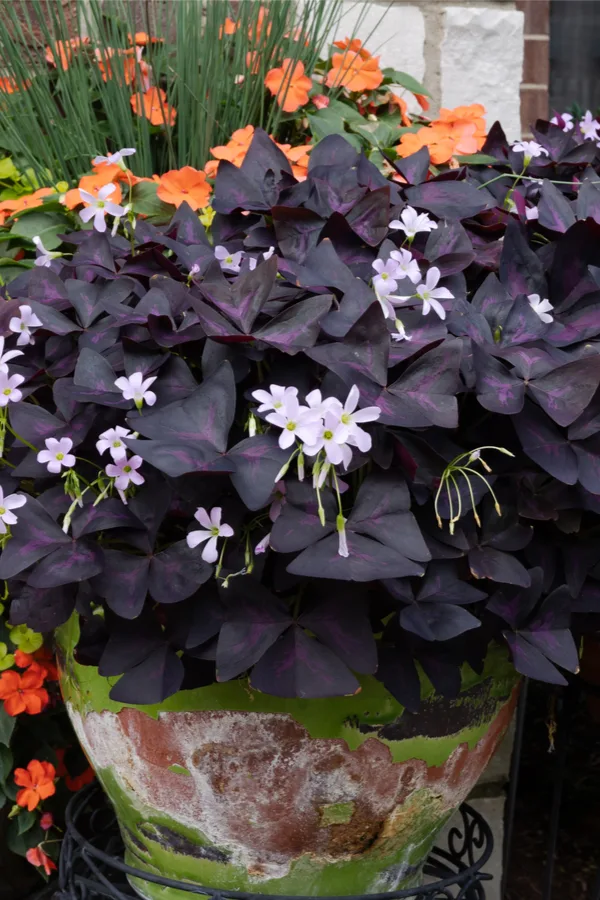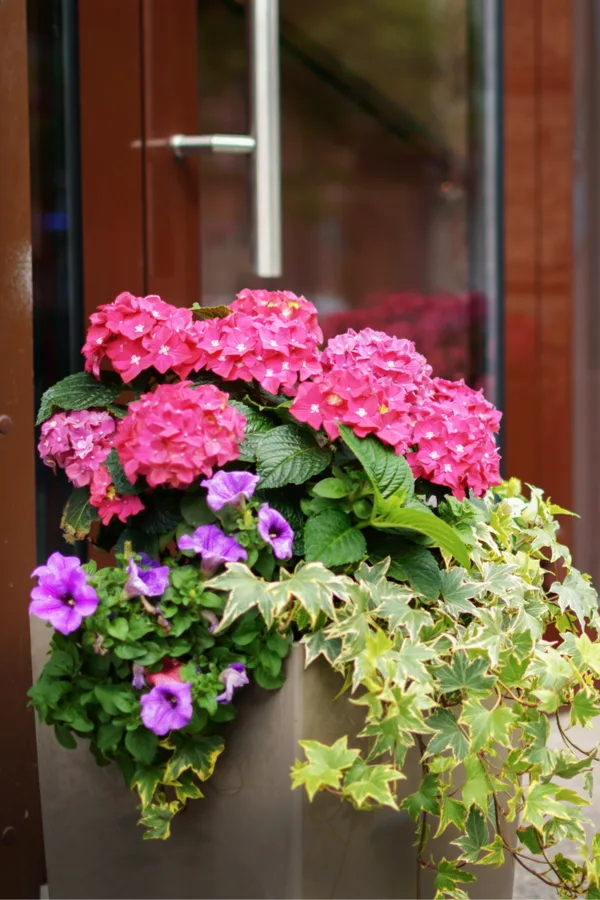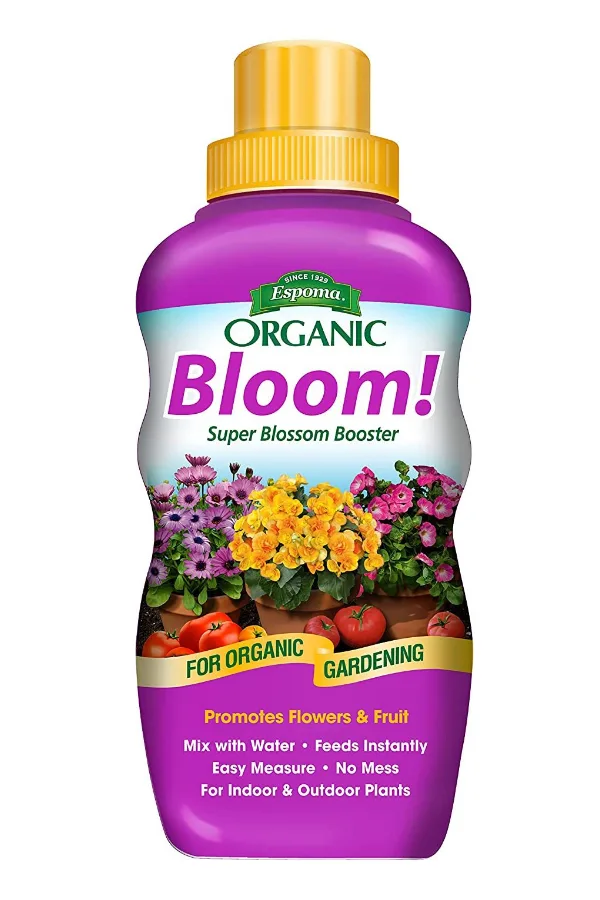When it comes to fertilizing your potted plants for success, what you use to power your plants and how often you apply it can have a big impact on the longevity of your flowering pots – including helping to keep your container plants blooming big all season long!
It’s hard to beat the beauty and elegance that container plantings bring to a home. Whether on a front porch, deck or walkway, planters can really bring color and texture to wherever they grow.
But there is nothing more frustrating than having your potted plants begin to fail. Especially if it happens long before summer is over! Not only can replanting with new plants be quite expensive, it can be time consuming as well.

The good news is, with a few timely applications of fertilizer, you can power up your container plants quite easily, allowing you to keep plants vibrant, healthy, and full of blooms all summer long. Here is a look at how to energize your plants for success, including when, how and what to use!
How To Fertilize Potted Plants
Potted plants have the disadvantage of growing with a limited amount of soil within the walls of their container. Unfortunately, no matter how fertile and rich the soil is, it will eventually run out of available nutrients. And it can happen in quick fashion.
As the roots of container plants grow and fill the pot, they draw moisture and nutrients from the soil. And all of that energy helps to power thick foliage and a heavy bloom set. The more energy available, the stronger the growth.
Early in the growing season, because the soil is still fertile, plants flower and bloom with ease. But as the soil becomes depleted of power, the plants begin to slow down.
Even with an adequate water supply, without power in the soil, the plants will eventually fail. And that is exactly where fertilizing your plants can save the day.

When To Start Fertilizing Potted Plants
The earlier you start your container plants on a regular fertilizing schedule, the better. Waiting until you begin to see the first signs of distress can put them behind the proverbial 8-ball when it comes to keeping your plants strong and healthy.
Applying small but regular doses early on to your potted plants is the biggest key to success. This keeps the growth steady and slow, which keeps plants blooming strong right through summer and fall.
When it comes to powering container plants, much as with hanging baskets, a two-prong approach works best. Dry, granular fertilizers can be applied to the top of the soil for low and slow feeding for foliage. Meanwhile, liquid fertilizers are perfect for feeding for better bloom sets.
Using Granular Fertilizers – How To Fertilize Potted Plants
As mentioned above, granular fertilizers provide slow and steady energy for your potted plants. Slow and steady is important, because too much energy can make plants produce lots of stems and leaves, but few flowers or fruit.

For potted plants, an all-purpose, balanced, slow release fertilizer should be applied monthly throughout the season. This will give steady power to the roots as the nutrients sink into the soil. For best results, use a fertilizer that has an N-P-K ratio in the range of 10-10-10- to 15-15-15.
An N-P-K ratio is the percentage of Nitrogen, Phosphorous and Potassium that is in the fertilizer. You want an equal amount to give plants a good balance of these nutrients for regular growth. Product Link : Osmocote 15-15-15 Smart-Release Plant Food.
As for how much to apply, it all depends on the size of your container and how many plants are in it. For smaller pots and containers, an 1/8th of a cup spread over the surface is usually adequate. For mid-size containers, use about a 1/4 of cup, and for oversized or large containers, a half a cup will do the trick.
Using Liquid Fertilizers – How To Fertilize Potted Plants
Liquid fertilizers are like an instant energy drink for plants. When used in conjunction with the slow and steady granular fertilizers, they can help to really power up blooms.
But unlike granular fertilizers, they should not be balanced. Instead, when applying a liquid fertilizer to potted flowers, you want the N-P-K ratio to have a higher number in the middle to provide more phosphorous.
In the N-P-K ratio, nitrogen is used by plants to provide foliage growth. Potassium, the “K” number, helps with plant health and disease prevention. That leaves the “P” or phosphorous number in the middle – and it just so happens that phosphorous helps to power blooms, flowers and fruiting.

By supplying a liquid dose of energy every few weeks that is high in phosphorous, it can keep your plants flowering and blooming big. Meanwhile, a lower nitrogen content will keep it from spending all of its energy trying to power more leaf and canopy growth.
The good news is, the monthly granular fertilizing provides plenty of nitrogen for continued steady growth.
There are many choices for liquid fertilizers on the market for powering more blooms. One of our favorites is Espomas liquid bloom booster. For one, it is organic, which is excellent if you happen to be growing vegetables or herbs in your pots. But even more, its formula is designed with providing more bloom power.
No matter your choice, remember to look for a higher middle number (phosphorous) to bring more blooming power to your plants!
Additional Factors For Powering Blooms – – How To Fertilize Potted Plants
It’s important to note that several other factors can figure in to keeping your plants blooming. First and foremost, practice regular deadheading of spent flowers to keep your plants powering new bloom sets.
Dying and decaying flowers and stems continue to draw resources from the plant. And since nutrients are limited in a container setting, conserving them is vital to keep plants blooming.

It is also extremely important to provide adequate water to your plants. Inconsistent watering can put a lot of stress on plants. And when plants have stress, they stop producing or highly limit bloom sets.
Here is to fertilizing your container plants for success this year, and getting the most out of your potted plants! Happy Gardening – Jim and Mary.
Jim and Mary Competti have been writing gardening, DIY and recipe articles and books for over 15 years from their 46 acre Ohio farm. The two are frequent speakers on all things gardening and love to travel in their spare time.
As always, feel free to email us at thefarm@owgarden.com with comments, questions, or to simply say hello! You can sign up for our free email list in the subscribe now box in the middle of this article. Follow us on Facebook here : OWG Facebook. This article may contain affiliate links.
